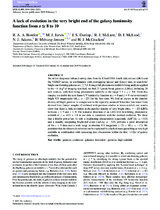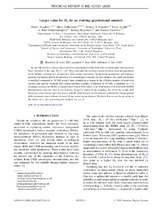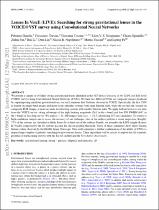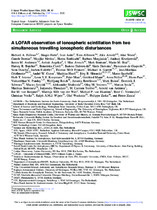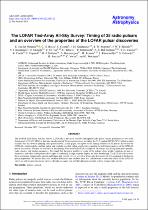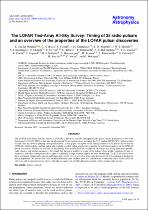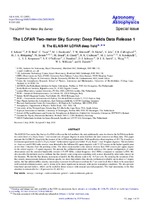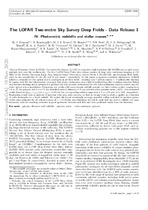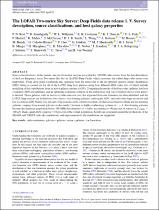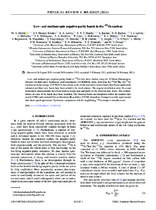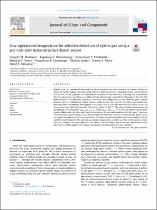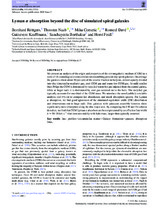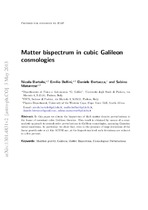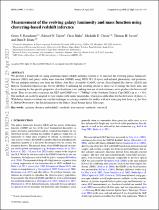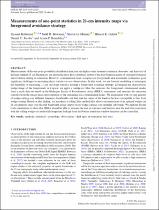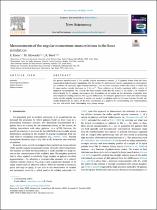Browsing Research Articles (Physics) by Title
Now showing items 266-285 of 510
-
A lack of evolution in the very bright end of the galaxy luminosity function from z 8 to 10
(Oxford University Press, 2020)ABSTRACT We utilize deep near-infrared survey data from the UltraVISTA fourth data release (DR4) and the VIDEO survey, in combination with overlapping optical and Spitzer data, to search for bright star-forming galaxies ... -
Larger value for H0 by an evolving gravitational constant
(American Physical Society, 2020)We provide further evidence that a massless cosmological scalar field with a nonminimal coupling to the Ricci curvature of the type M 2 pl ( 1 + ξ σ n / M n pl ) alleviates the existing tension between ... -
Lenses In VoicE (LIVE): Searching for strong gravitational lenses in the VOICE@VST survey using Convolutional Neural Networks
(Monthly notices of the Royal Astronomical Society, 2021)We present a sample of 16 likely strong gravitational lenses identified in the VST Optical Imaging of the CDFS and ES1 fields (VOICE survey) using Convolutional Neural Networks (CNNs). We train two different CNNs on composite ... -
A LOFAR observation of ionospheric scintillation from two simultaneous travelling ionospheric disturbances
(The Journal of Space Weather and Space Climate, 2020)This paper presents the results from one of the first observations of ionospheric scintillation taken using the Low-Frequency Array (LOFAR). The observation was of the strong natural radio source Cassiopeia A, taken ... -
The lofar tied-array all-sky survey: Timing of 35 radio pulsars and an overview of the properties of the lofar pulsar discoveries
(EDP Sciences, 2023)The LOFAR Tied-Array All-Sky Survey (LOTAAS) is the most sensitive untargeted radio pulsar survey performed at low radio frequencies (119−151 MHz) to date and has discovered 76 new radio pulsars, including the 23.5-s ... -
The LOFAR Tied-Array All-Sky Survey: Timing of 35 radio pulsars and an overview of the properties of the LOFAR pulsar discoveries
(Astronomy& Astrophysics, 2023)The LOFAR Tied-Array All-Sky Survey (LOTAAS) is the most sensitive untargeted radio pulsar survey performed at low radio frequencies (119−151 MHz) to date and has discovered 76 new radio pulsars, including the 23.5-s pulsar ... -
The lofar two-meter sky survey: Deep fields data release 1: II. The elais-n1 lofar deep field
(EDP Sciences, 2021)The LOFAR Two-metre Sky Survey (LoTSS) will cover the full northern sky and, additionally, aims to observe the LoTSS deep fields to a noise level of ? 10 μJy beam-1 over several tens of square degrees in areas that have ... -
The lofar two-meter sky survey: Deep fields data release 1: IV. Photometric redshifts and stellar masses
(EDP Sciences, 2021)The Low Frequency Array (LOFAR) Two-metre Sky Survey (LoTSS) is a sensitive, high-resolution 120-168 MHz survey split across multiple tiers over the northern sky. The first LoTSS Deep Fields data release consists of deep ... -
The LOFAR Two-metre sky survey deep fields: The star-formation rate-radio luminosity relation at low frequencies
(EDP Sciences, 2021)In this paper, we investigate the relationship between 150 MHz luminosity and the star-formation rate - the SFR-L150 MHz relation - using 150 MHz measurements for a near-infrared selected sample of 118 517 z < 1 galaxies. ... -
The lofar two-metre sky survey: Deep fields data release 1. V. Survey description, source classifications, and host galaxy properties
(Oxford University Press, 2023)Source classifications, stellar masses, and star-formation rates are presented for ≈80 000 radio sources from the first data release of the Low Frequency Array Two-metre Sky Survey (LoTSS) Deep Fields, which represents the ... -
Low- And medium-spin negative-parity bands in the Os 187 nucleus
(American Physical Society, 2021)Low- and medium-spin negative-parity bands of Os187 have been studied using the AFRican Omnipurpose Detector for Innovative Techniques and Experiments (AFRODITE) array, following the W186(He4,3n)Os187 reaction at a beam ... -
Low-operational temperature for selective detection of xylene gas using a p-n CuO-ZnO heterostructure-based sensor
(Elsevier Ltd, 2023)Xylene is not just considered detrimental to the environment but also hazardous to humans. Herein we report on xylene vapour detection using CuO-ZnO heterostructures containing various concentrations (0.1–2.0 wt%) of Zn, ... -
Lyman α absorption beyond the disc of simulated spiral galaxies
(Oxford University Press, 2020)We present an analysis of the origin and properties of the circumgalactic medium (CGM) in a suite of 11 cosmological zoom simulations resembling present-day spiral galaxies. On average the galaxies retain about 50 per cent ... -
MAMMOTH: Confirmation of two massive galaxy overdensities at z = 2.24 with Hα emitters
(Oxford University Press, 2021)Massive galaxy overdensities at the peak epoch of cosmic star formation provide ideal testbeds for the formation theories of galaxies and large-scale structure. We report the confirmation of two massive galaxy overdensities ... -
Matter bispectrum in cubic Galileon cosmologies
(IOP Science, 2013)In this paper we obtain the bispectrum of dark matter density perturbations in the frame of covariant cubic Galileon theories. This result is obtained by means of a semi- analytic approach to second-order perturbations ... -
Maximum sprite streamer luminosity near the stratopause
(AGU Advances, 2019)Sprites are composed of numerous streamers which exhibit transient luminosities in the upper middle atmosphere above thunderclouds after initiation by an intense positive lightning discharge, often followed by lightning ... -
Measurement and analysis of nuclear γ-ray production cross sections in proton interactions with Mg, Si, and Fe nuclei abundant in astrophysical sites over the incident energy range E = 30–66 MeV
(American Physical Society, 2020)The modeling of nuclear γ -ray line emission induced by highly accelerated particles in astrophysical sites (e.g., solar flares, the gas and dust in the inner galaxy) and the comparison with observed emissions from these ... -
Measurement of the evolving galaxy luminosity and mass function using clustering-based redshift inference
(Monthly Notices of the Royal Astronomical Society, 2023)We develop a framework for using clustering-based redshift inference (cluster-z ) to measure the evolving galaxy luminosity function (GLF) and galaxy stellar mass function (GSMF) using Wide-field Infrared Survey Explorer ... -
Measurements of one-point statistics in 21-cm intensity maps via foreground avoidance strategy
(Oxford University Press, 2022)Measurements of the one-point probability distribution function and higher-order moments (variance, skewness, and kurtosis) of the high-redshift 21-cm fluctuations are among the most directstatistical probes of the ... -
Measurements of the angular momentum–mass relations in the Simba simulation
(New Astronomy, 2023)We present measurements of the specific angular momentum content (𝑗) of galaxies drawn from the Simba cosmological hydrodynamic simulations. These relations are broadly consistent with a variety of empirical measurements. ...

